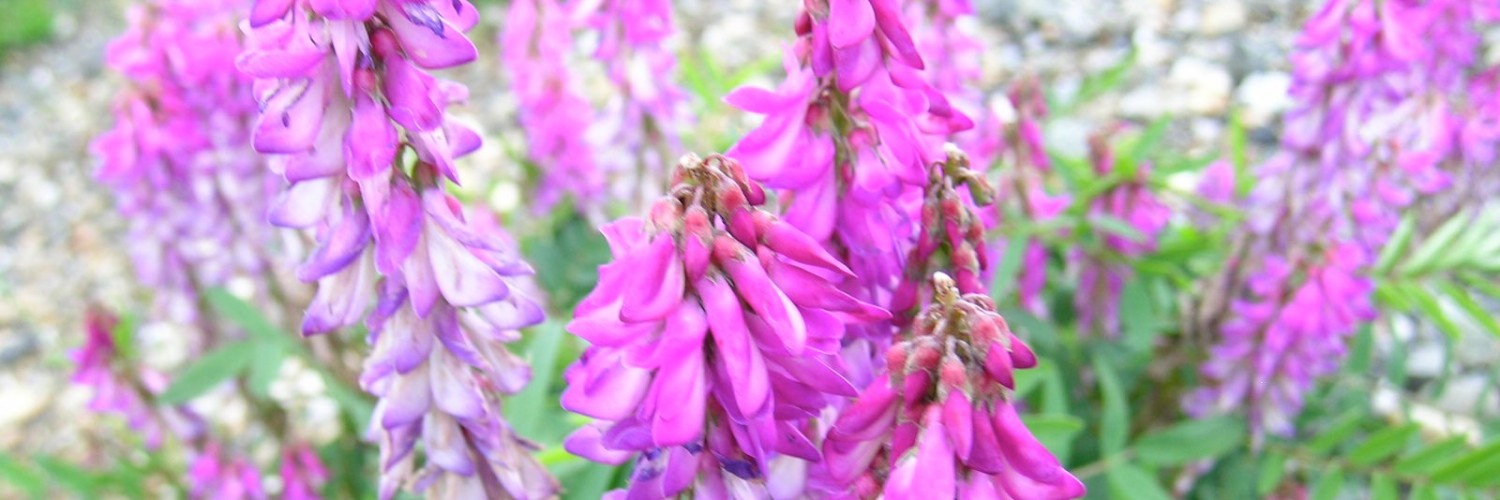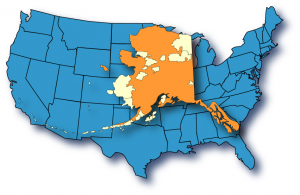The state of Alaska is vast, and many consider it a “bucket list” destination. It is the largest state in the Union — more than twice the size of the next largest state, Texas. Superimposing a map of the state over one of the contiguous United States shows just how big it is: from the panhandle in the east to the tip of the Aleutian chain in the west, the state would stretch from Florida to California!
Many of Alaska’s communities are not on the road system, and are only accessible by plane (year-round) or boat (during the short summer season). Even the capital, Juneau, is only accessible by plane or boat, as it is not on the road system itself! As a result, most visitors to the state manage to see only a glimpse of all the state has to offer.
The 2016 Summer Institute will take place in Fairbanks, in the heart of Alaska’s interior. Participants will have ample opportunity to explore the areas around Fairbanks. However, due to the great distance between Fairbanks and other locations, the institute will not include travel to such places as Anchorage, Seward, or Denali National Park. As a result, you may wish to extend your stay — either arriving before the Summer Institute begins on the evening of the 14th, or staying after the Institute ends on the evening of the 26th.
PLEASE NOTE: July is in the middle of a busy tourist season for the state. If you wish to extend your stay, we recommend that you make your travel and lodging reservations as soon as possible.
Below, we’ve listed some travel suggestions for extending your stay.
Denali National Park
Denali National Park is six million acres of wilderness — taiga forest, alpine tundra, and mountains, including North America’s tallest peak — Denali. In addition to awe inspiring views, many visitors have the chance to observe wildlife — Dall sheep, bears, wolves, hares, ptarmigan, birds, moose, and caribou.
A single, 92-mile road, with restricted vehicle access, bisects the park. Tour busses offer visitors a chance to access the wilderness beyond mile 15. Lodging is available at one of several hotels near the park entrance; as well, there is a campground near the entrance, and remote backpacking / camping areas inside the park.
Getting to Denali
By Car
Denali National Park entrance is on the George Parks Highway (Highway 3), approximately 120 miles south of Fairbanks (193 km), and 240 miles (386 km) north of Anchorage. Vehicles can be rented at the Fairbanks and Anchorage International Airports.
By Train
Visitors can also reach the park by train; the Alaska Railroad connects Seward to Fairbanks and offers visitors a scenic way to travel. For more information on traveling by train, please visit the the Alaska Railroad website.
Staying in Denali
A number of hotels, cabins, and bed and breakfasts are located outside the park entrance. As well, the Kantishna Roadhouse, located in the heart of the park, offers a unique experience for visitors.
A list of major hotels located near the park can be found on the Alaska Travel site. Other hotels, wilderness lodges, and bed and breakfasts can be found at Alaska.org.
More information on Denali National Park can be found at the National Parks Service website.
SOUTH-CENTRAL
Anchorage
Anchorage is Alaska’s largest city, located in the south-central part of the state on the Cook Inlet. The city offers all the amenities of a large city, but is centrally located to many great outdoor adventures.
- The Anchorage Museum and the Alaska Native Heritage Center offer in-depth art and history from Alaska’s many Native cultures.
- Scenic Day Drives offer visitors the chance to take in coastal views on Turnagain Arm, alpine tundra in Hatcher Pass, or views of the Matanuska Glacier.
- The Coastal Trail is a 15-mile walking / biking trail that follows the coast beginning in downtown.
- Day Cruises to Prince William Sound or the Kenai Fjords can also be accessed from Anchorage.
Seward
The coastal community of Seward is just 2.5 hours south of Anchorage. Here, visitors can explore the Kenai Fjords, the Alaska Sealife Center, Resurrection Bay, and Exit Glacier, or charter adventures to fish for halibut or salmon. Seward is accessible by car, boat, or train.
Homer / Kenai
Another seaside community within driving distance of Anchorage (4-5 hours), Homer offers visitors the opportunity to fish for halibut or salmon, whale watch on Kachemak Bay, and take in stunning coastal views along its famous spit. Homer is accessible by plane or car.
Palmer / Wasilla
The Palmer / Wasilla area is home to the Matanuska Valley — Alaska’s largest commercial agricultural area. It is a short 45-minute drive from Anchorage.
Valdez
Another gold rush town, Valdez is located at the head of a fjord on Prince William Sound near the Chugach Mountains. Valdez is also famous for being the end of the Trans-Alaska Pipeline — where oil pumped in Prudhoe Bay is loaded onto ships in the oil terminal. Visitors can take a number of glacier cruises, go rafting or kayaking, or charter a fishing adventure. Valdez can be accessed by car (approximately 6 hours from Anchorage), ferry, or plane.
ARCTIC
Nome
Perhaps the most famous gold rush town in Alaska, Nome is well-known for its history. It is located at the tip of the Seward Peninsula; in one direction visitors can look out at the Bering Sea, in another, they can look across the arctic tundra. Nome is not on the state road system, and is accessible only by plane. The town of Nome marks the end of the Iditarod Sled Dog Race, which happens every spring, a 1049-mile race from Anchorage, commemorating the diphtheria serum run.
Barrow
The Native Iñupiat village of Barrow is the farthest north major village in Alaska, and the northernmost city in the United States. It is accessible only by plane, and is quite small. Visitors can learn about the local culture at the Iñupiat Heritage Center.
Gates of the Arctic National Park and Preserve
Gates of the Arctic National Park is a vast wilderness where visitors are truly on their own. There are no amenities — no roads or trails; no cell phone service; no markets or hotels. More information about planning a backcountry trip to Gates of the Arctic, as well as a list of outfitters can be found at the National Parks Service website.
THE INSIDE PASSAGE
Juneau
Alaska’s capital, Juneau, is accessible only by boat or plane. Popular tourist destinations in the area include the Mendenhall Glacier, the Alaska State Museum, the Juneau Icefield, and Mount Juneau and Mount Roberts (which is also accessible by taking the Mount Roberts Tramway). Juneau is also a primary stop for many summer cruise ships coming through the Inside Passage.
Glacier Bay National Park
Glacier Bay National Park is located near the small town of Gustavus. It is accessible only by plane or ferry. Visitors can take a 9-hour, ranger-led boat trip to see the glaciers, hike three trails around Bartlett Cove, kayak with a guide, go sport fishing, or camp in the walk-in campground. A traditional Tlingit tribal house is under construction on the shores of Bartlett Cove, and is scheduled for completion this summer.
SOUTHWEST
Kodiak
Kodiak is best known for its brown bears. The town, 200 miles offshore from Homer, is accessible only by ferry or plane. Visitors can go fishing, visit several museums, the Fisheries Research Center, Fort Abercrombie State Park, or fly to the Frazer River and watch the famous bears feeding on salmon.
Katmai National Park and Preserve
Katmai National Park and Preserve is home to North America’s largest protected population of brown bears. Viewing platforms allow visitors to watch the bears doing their thing — fishing, eating, playing, resting. Visitors to the park can also visit The Valley of 10,000 Smokes — so named for volcanic vents of steam.
For more information on planning your extended stay, the Visitor page at the State of Alaska, Alaska.org, the Travel Alaska, and the Alaska Railroad websites are useful tools.


